Seat Alhambra 2009 Owner's Manual
Manufacturer: SEAT, Model Year: 2009, Model line: Alhambra, Model: Seat Alhambra 2009Pages: 285, PDF Size: 7.62 MB
Page 241 of 285
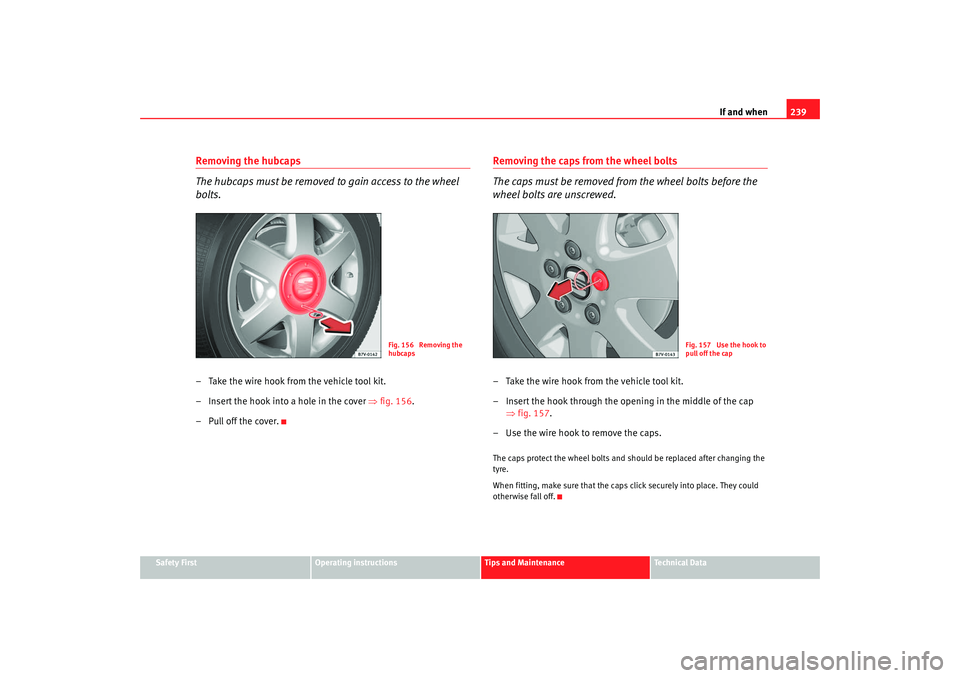
If and when239
Safety First
Operating instructions
Tips and Maintenance
Te c h n i c a l D a t a
Removing the hubcaps
The hubcaps must be removed to gain access to the wheel
bolts.– Take the wire hook from the vehicle tool kit.
– Insert the hook into a hole in the cover ⇒fig. 156.
– Pull off the cover.
Removing the caps from the wheel bolts
The caps must be removed from the wheel bolts before the
wheel bolts are unscrewed.– Take the wire hook from the vehicle tool kit.
– Insert the hook through the opening in the middle of the cap ⇒fig. 157 .
– Use the wire hook to remove the caps.The caps protect the wheel bolts and should be replaced after changing the
tyre.
When fitting, make sure that the caps click securely into place. They could
otherwise fall off.
Fig. 156 Removing the
hubcaps
Fig. 157 Use the hook to
pull off the cap
alhambra_aleman.book Seite 239 Montag, 23. M‰ rz 2009 1:12 13
Page 242 of 285
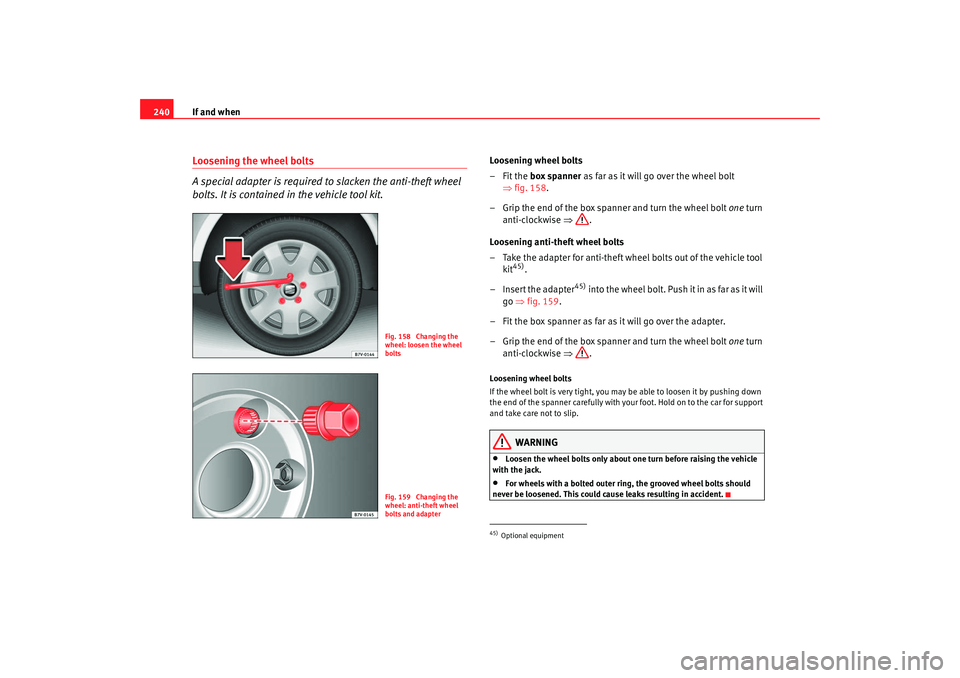
If and when
240Loosening the wheel bolts
A special adapter is required to slacken the anti-theft wheel
bolts. It is contained in the vehicle tool kit.
Loosening wheel bolts
–Fit the box spanner as far as it will go over the wheel bolt
⇒ fig. 158.
– Grip the end of the box spanner and turn the wheel bolt one turn
anti-clockwise ⇒.
Loosening anti-theft wheel bolts
– Take the adapter for anti-theft wheel bolts out of the vehicle tool kit
45)
.
– Insert the adapter
45)
into the wheel bolt. Push it in as far as it will
go ⇒fig. 159 .
– Fit the box spanner as far as it will go over the adapter.
– Grip the end of the box spanner and turn the wheel bolt one turn
anti-clockwise ⇒.
Loosening wheel bolts
If the wheel bolt is very tight, you may be able to loosen it by pushing down
the end of the spanner carefully with your foot. Hold on to the car for support
and take care not to slip.
WARNING
•
Loosen the wheel bolts only about one turn before raising the vehicle
with the jack.
•
For wheels with a bolted outer ring, the grooved wheel bolts should
never be loosened. This could cause leaks resulting in accident.
Fig. 158 Changing the
wheel: loosen the wheel
boltsFig. 159 Changing the
wheel: anti-theft wheel
bolts and adapter
45)Optional equipment
alhambra_aleman.book Seite 240 Montag, 23. M‰ rz 2009 1:12 13
Page 243 of 285
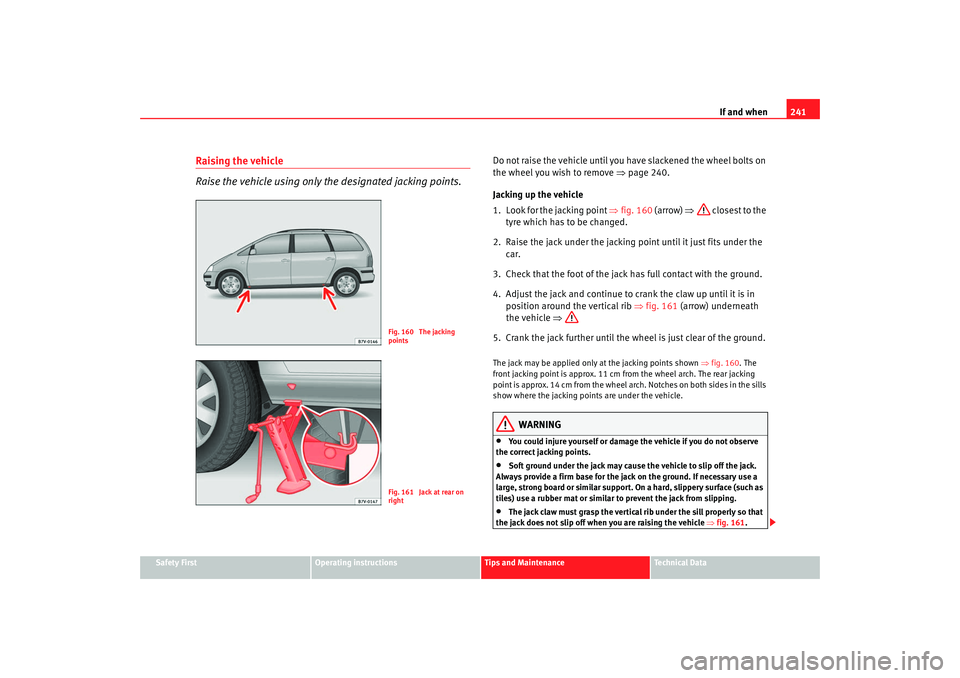
If and when241
Safety First
Operating instructions
Tips and Maintenance
Te c h n i c a l D a t a
Raising the vehicle
Raise the vehicle using only the designated jacking points.
Do not raise the vehicle until you have slackened the wheel bolts on
the wheel you wish to remove ⇒page 240.
Jacking up the vehicle
1. Look for the jacking point ⇒fig. 160 (arrow) ⇒ closest to the
tyre which has to be changed.
2. Raise the jack under the jacking point until it just fits under the car.
3. Check that the foot of the jack has full contact with the ground.
4. Adjust the jack and continue to crank the claw up until it is in position around the vertical rib ⇒fig. 161 (arrow) underneath
the vehicle ⇒
5. Crank the jack further until the wheel is just clear of the ground.The jack may be applied only at the jacking points shown ⇒fig. 160 . The
front jacking point is approx. 11 cm from the wheel arch. The rear jacking
point is approx. 14 cm from the wheel arch. Notches on both sides in the sills
show where the jacking points are under the vehicle.
WARNING
•
You could injure yourself or damage the vehicle if you do not observe
the correct jacking points.
•
Soft ground under the jack may cause the vehicle to slip off the jack.
Always provide a firm base for the jack on the ground. If necessary use a
large, strong board or similar support. On a hard, slippery surface (such as
tiles) use a rubber mat or similar to prevent the jack from slipping.
•
The jack claw must grasp the vertical rib under the sill properly so that
the jack does not slip off when you are raising the vehicle ⇒ fig. 161.
Fig. 160 The jacking
pointsFig. 161 Jack at rear on
right
alhambra_aleman.book Seite 241 Montag, 23. M‰ rz 2009 1:12 13
Page 244 of 285
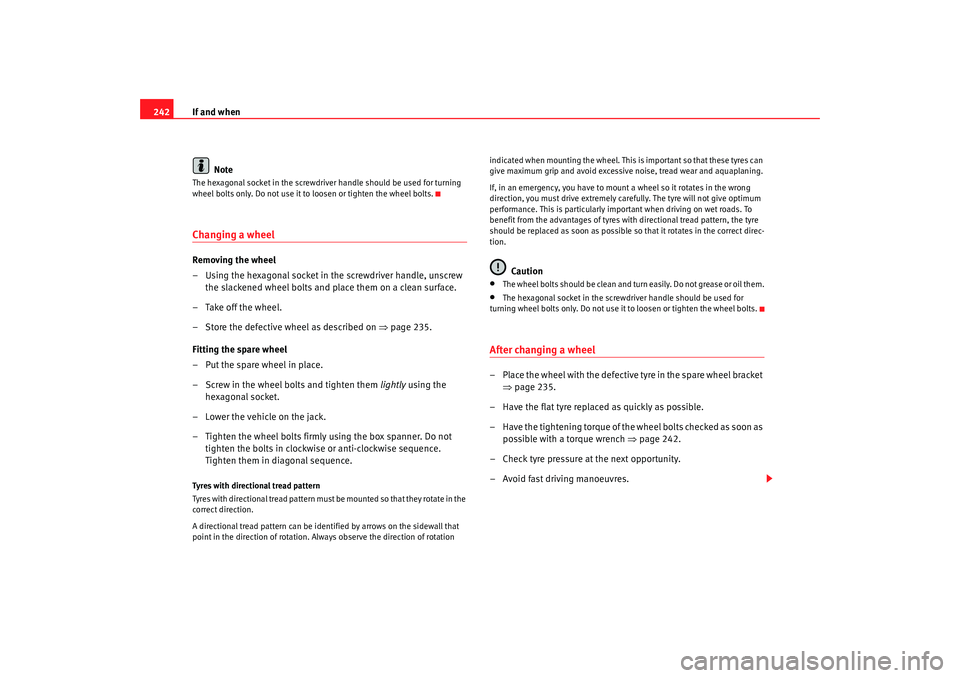
If and when
242
NoteThe hexagonal socket in the screwdriver handle should be used for turning
wheel bolts only. Do not use it to loosen or tighten the wheel bolts.Changing a wheel Removing the wheel
– Using the hexagonal socket in the screwdriver handle, unscrew
the slackened wheel bolts and place them on a clean surface.
– Take off the wheel.
– Store the defective wheel as described on ⇒page 235.
Fitting the spare wheel
– Put the spare wheel in place.
– Screw in the wheel bolts and tighten them lightly using the
hexagonal socket.
– Lower the vehicle on the jack.
– Tighten the wheel bolts firmly using the box spanner. Do not tighten the bolts in clockwise or anti-clockwise sequence.
Tighten them in diagonal sequence.Tyres with directional tread pattern
Tyres with directional tread pattern must be mounted so that they rotate in the
correct direction.
A directional tread pattern can be identified by arrows on the sidewall that
point in the direction of rotation. Always observe the direction of rotation indicated when mounting the wheel. This is important so that these tyres can
give maximum grip and avoid excessive noise, tread wear and aquaplaning.
If, in an emergency, you have to mount a wheel so it rotates in the wrong
direction, you must drive extremely carefully. The tyre will not give optimum
performance. This is particularly important when driving on wet roads. To
benefit from the advantages of tyres with directional tread pattern, the tyre
should be replaced as soon as possible so that it rotates in the correct direc-
tion.
Caution
•
The wheel bolts should be clean and turn easily. Do not grease or oil them.
•
The hexagonal socket in the screwdriver handle should be used for
turning wheel bolts only. Do not use it to loosen or tighten the wheel bolts.
After changing a wheel– Place the wheel with the defective tyre in the spare wheel bracket ⇒page 235.
– Have the flat tyre replaced as quickly as possible.
– Have the tightening torque of the wheel bolts checked as soon as possible with a torque wrench ⇒page 242.
– Check tyre pressure at the next opportunity.
– Avoid fast driving manoeuvres.
alhambra_aleman.book Seite 242 Montag, 23. M‰ rz 2009 1:12 13
Page 245 of 285
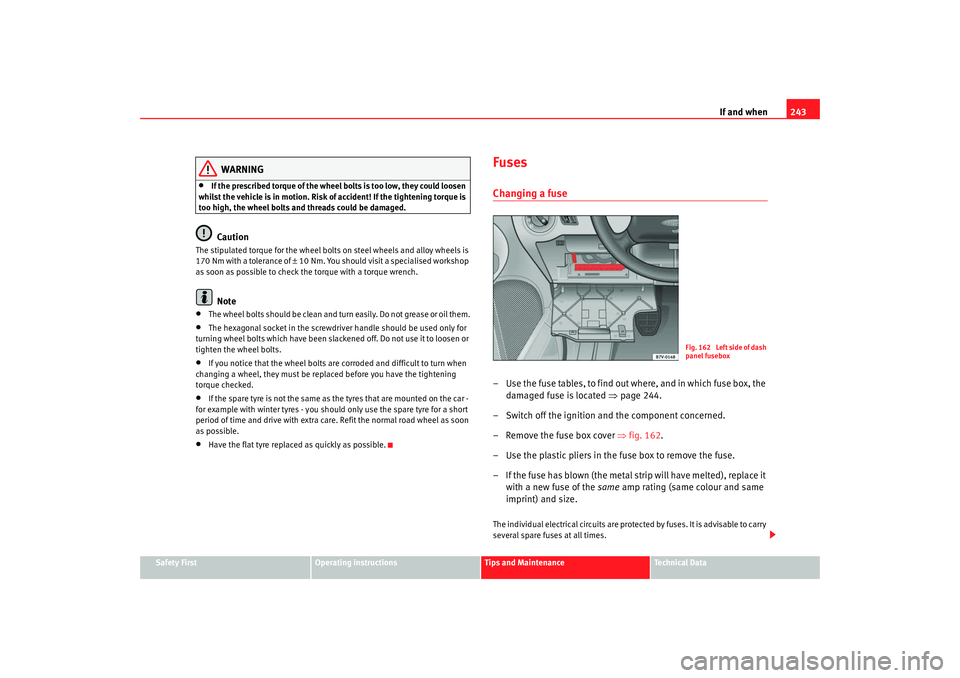
If and when243
Safety First
Operating instructions
Tips and Maintenance
Te c h n i c a l D a t a
WARNING
•
If the prescribed torque of the wheel bolts is too low, they could loosen
whilst the vehicle is in motion. Risk of accident! If the tightening torque is
too high, the wheel bolts and threads could be damaged.Caution
The stipulated torque for the wheel bolts on steel wheels and alloy wheels is
170 Nm with a tolerance of ±10 Nm. You should visit a specialised workshop
as soon as possible to check the torque with a torque wrench.
Note
•
The wheel bolts should be clean and turn easily. Do not grease or oil them.
•
The hexagonal socket in the screwdriver handle should be used only for
turning wheel bolts which have been slackened off. Do not use it to loosen or
tighten the wheel bolts.
•
If you notice that the wheel bolts are corroded and difficult to turn when
changing a wheel, they must be replaced before you have the tightening
torque checked.
•
If the spare tyre is not the same as the tyres that are mounted on the car -
for example with winter tyres - you should only use the spare tyre for a short
period of time and drive with extra care. Refit the normal road wheel as soon
as possible.
•
Have the flat tyre replaced as quickly as possible.
FusesChanging a fuse– Use the fuse tables, to find out where, and in which fuse box, the damaged fuse is located ⇒ page 244.
– Switch off the ignition and the component concerned.
– Remove the fuse box cover ⇒fig. 162 .
– Use the plastic pliers in the fuse box to remove the fuse.
– If the fuse has blown (the metal strip will have melted), replace it with a new fuse of the same amp rating (same colour and same
imprint) and size.The individual electrical circuits are protected by fuses. It is advisable to carry
several spare fuses at all times.
F ig . 1 6 2 Le f t si d e o f d as h
panel fusebox
alhambra_aleman.book Seite 243 Montag, 23. M‰ rz 2009 1:12 13
Page 246 of 285
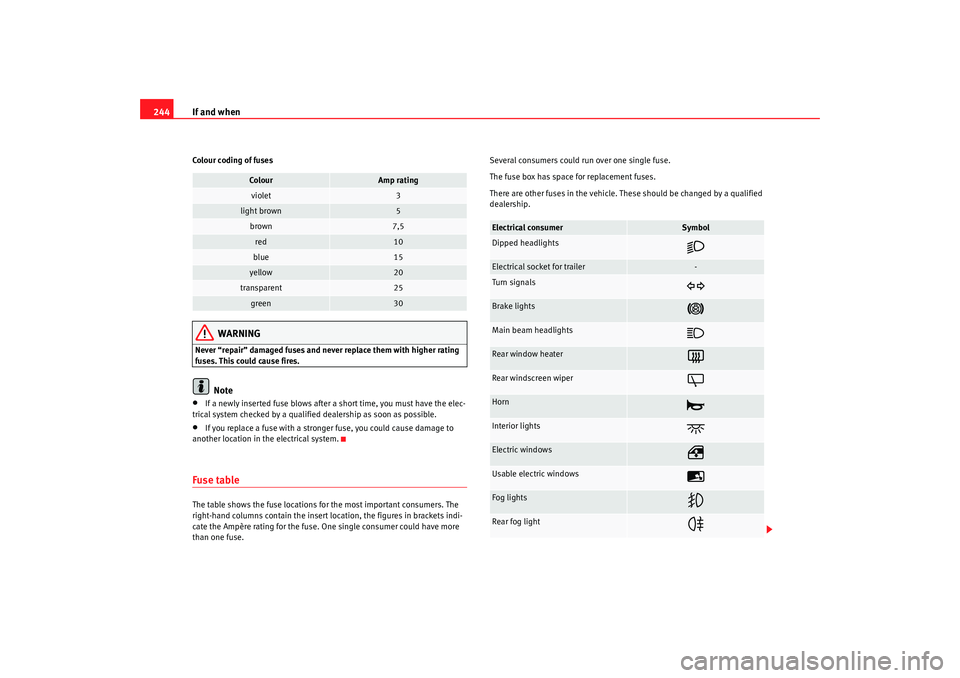
If and when
244Colour coding of fuses
WARNING
Never “repair” damaged fuses and never replace them with higher rating
fuses. This could cause fires.
Note
•
If a newly inserted fuse blows after a short time, you must have the elec-
trical system checked by a qualified dealership as soon as possible.
•
If you replace a fuse with a stronger fuse, you could cause damage to
another location in the electrical system.
Fuse tableThe table shows the fuse locations for the most important consumers. The
right-hand columns contain the insert location, the figures in brackets indi-
cate the Ampère rating for the fuse. One single consumer could have more
than one fuse. Several consumers could run over one single fuse.
The fuse box has space for replacement fuses.
There are other fuses in the vehicle. These should be changed by a qualified
dealership.
Colour
Amp rating
violet
3
light brown
5
brown
7,5
red
10
blue
15
yellow
20
transparent
25
green
30
Electrical consumer
Symbol
Dipped headlights
Electrical socket for trailer
-
Turn signals
Brake lights
Main beam headlights
Rear window heater
Rear windscreen wiper
Horn
Interior lights
Electric windows
Usable electric windows
Fog lights
Rear fog light
alhambra_aleman.book Seite 244 Montag, 23. M‰
rz 2009 1:12 13
Page 247 of 285

If and when245
Safety First
Operating instructions
Tips and Maintenance
Te c h n i c a l D a t a
Changing a lightBulbs, changing
Bulbs should be changed by a professional mechanic only.Technical knowledge is required to change bulbs. This is because, in certain
cases, access can be gained only by removing other vehicle components.
This applies in particular to bulbs which can be accessed only from the
engine compartment.
We recommend bulbs are changed by a qualified dealership or, if this is not
possible, by a qualified person.
However, if you wish to change the bulb, please observe the following:
Before changing a bulb, you must switch off the light (light switch in O posi-
tion), and the turn signal lever must be in the neutral position.
Always replace damaged bulbs with identical bulbs with the same designa-
tion. The type is inscribed on the bulb, either on the glass or on the base.
You should store spare light bulbs in the vehicle for safety-relevant lights.
Bulbs can be obtained from SEAT Service Centres.
WARNING
•
The high voltage element of gas discharge lamps must be handled
correctly. Failure to comply could result in fatal injuries.
•
H7* bulbs are pressurised and could explode when they are being
changed. Risk of injury.
•
In vehicles fitted with gas discharge lamps*, there is a mortal danger if
the high voltage section of the lamp is incorrectly handled.
•
When working in the engine compartment, always observe the safety
warnings ⇒page 211.
Hazard warning light switch
Instrument panel lighting
Climate control
Heating
Radio, navigation system
/
Rear light
-
Registration plate light
Windscreen washers
Windscreen washer system
Sliding sunroof
Seat heating
Mirror adjustment
Heating the exterior mirrors
Side lights
Socket (luggage compartment)
Central locking.
-
Electrical consumer
Symbol
alhambra_aleman.book Seite 245 Montag, 23. M‰ rz 2009 1:12 13
Page 248 of 285
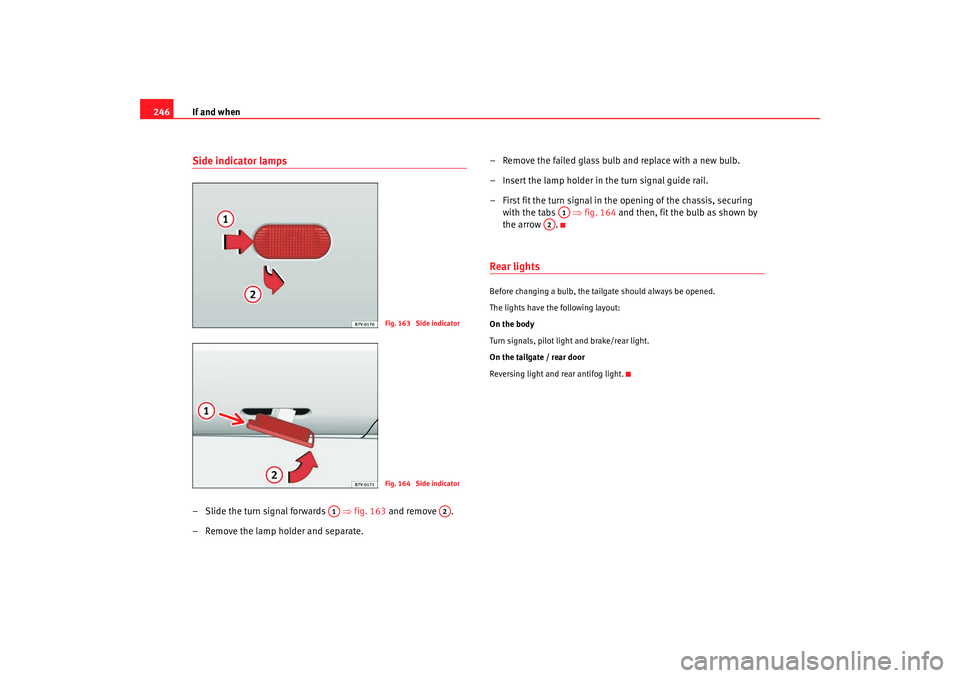
If and when
246Side indicator lamps– Slide the turn signal forwards ⇒fig. 163 and remove .
– Remove the lamp holder and separate. – Remove the failed glass bulb and replace with a new bulb.
– Insert the lamp holder in the turn signal guide rail.
– First fit the turn signal in the opening of the chassis, securing
with the tabs ⇒fig. 164 and then, fit the bulb as shown by
the arrow .
Rear lightsBefore changing a bulb, the tailgate should always be opened.
The lights have the following layout:
On the body
Turn signals, pilot light and brake/rear light.
On the tailgate / rear door
Reversing light and rear antifog light.
Fig. 163 Side indicatorFig. 164 Side indicator
A1
A2
A1
A2
alhambra_aleman.book Seite 246 Montag, 23. M‰ rz 2009 1:12 13
Page 249 of 285
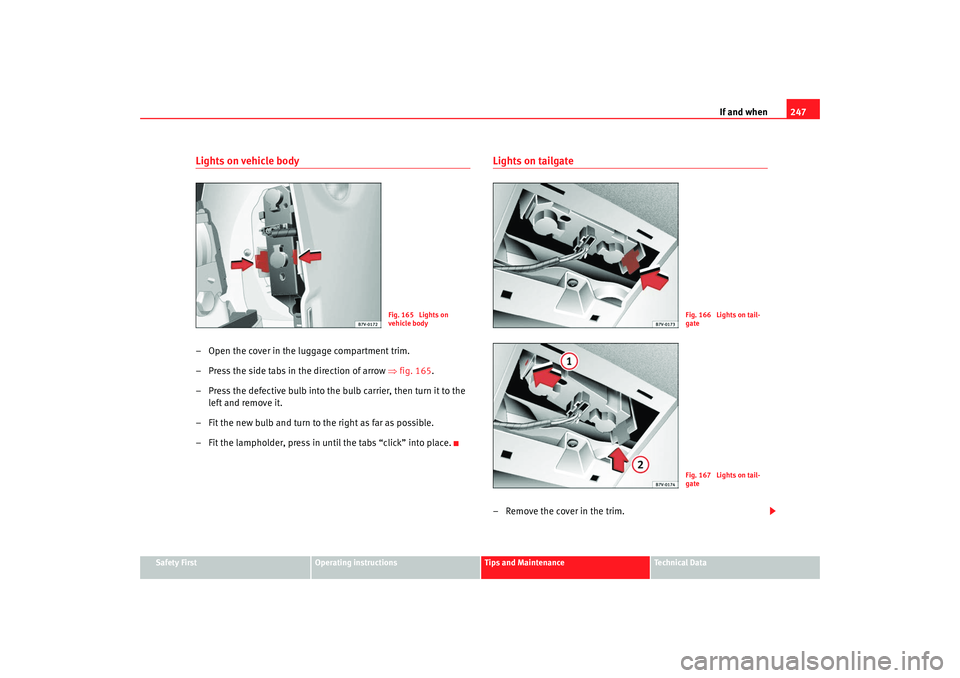
If and when247
Safety First
Operating instructions
Tips and Maintenance
Te c h n i c a l D a t a
Lights on vehicle body – Open the cover in the luggage compartment trim.
– Press the side tabs in the direction of arrow ⇒fig. 165.
– Press the defective bulb into the bulb carrier, then turn it to the left and remove it.
– Fit the new bulb and turn to the right as far as possible.
– Fit the lampholder, press in until the tabs “click” into place.
Lights on tailgate– Remove the cover in the trim.
Fig. 165 Lights on
vehicle body
Fig. 166 Lights on tail-
gateFig. 167 Lights on tail-
gate
alhambra_aleman.book Seite 247 Montag, 23. M‰ rz 2009 1:12 13
Page 250 of 285
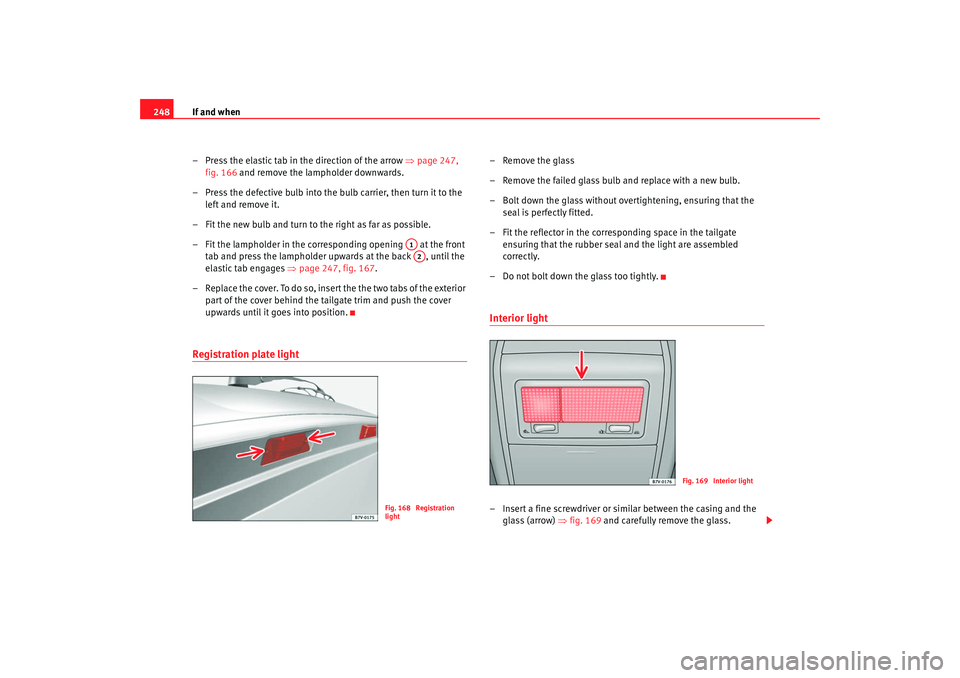
If and when
248
– Press the elastic tab in the direction of the arrow ⇒page 247,
fig. 166 and remove the lampholder downwards.
– Press the defective bulb into the bulb carrier, then turn it to the left and remove it.
– Fit the new bulb and turn to the right as far as possible.
– Fit the lampholder in the corresponding opening at the front tab and press the lampholder upwards at the back , until the
elastic tab engages ⇒page 247, fig. 167 .
– Replace the cover. To do so, insert the the two tabs of the exterior part of the cover behind the tailgate trim and push the cover
upwards until it goes into position.Registration plate light
– Remove the glass
– Remove the failed glass bulb and replace with a new bulb.
– Bolt down the glass without overtightening, ensuring that the
seal is perfectly fitted.
– Fit the reflector in the corresponding space in the tailgate ensuring that the rubber seal and the light are assembled
correctly.
– Do not bolt down the glass too tightly.Interior light– Insert a fine screwdriver or similar between the casing and the glass (arrow) ⇒fig. 169 and carefully remove the glass.
A1A2
Fig. 168 Registration
light
Fig. 169 Interior light
alhambra_aleman.book Seite 248 Montag, 23. M‰ rz 2009 1:12 13